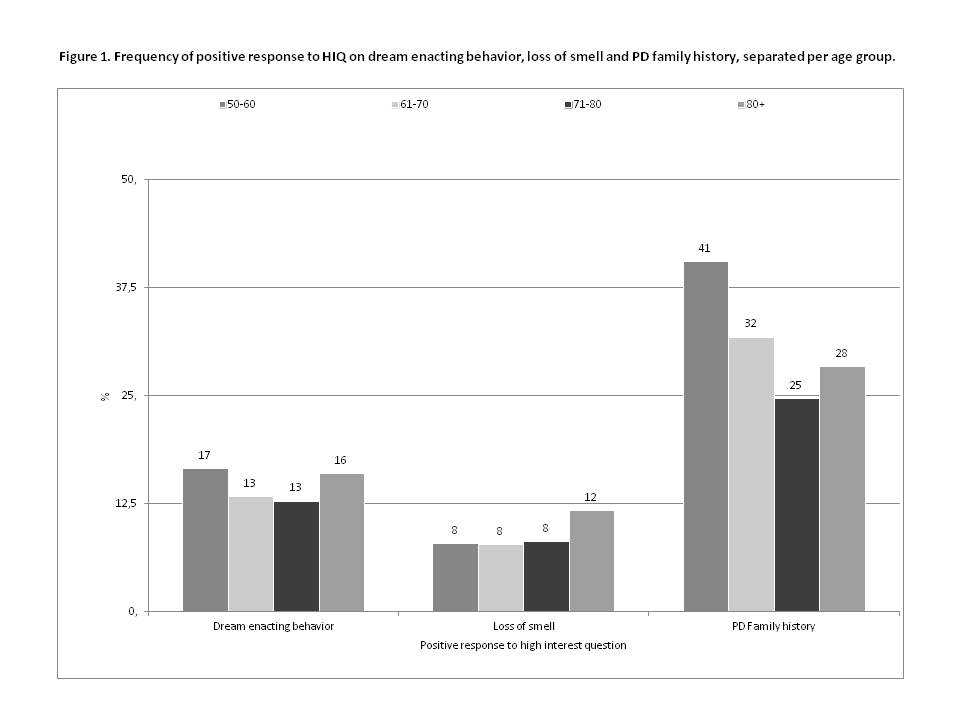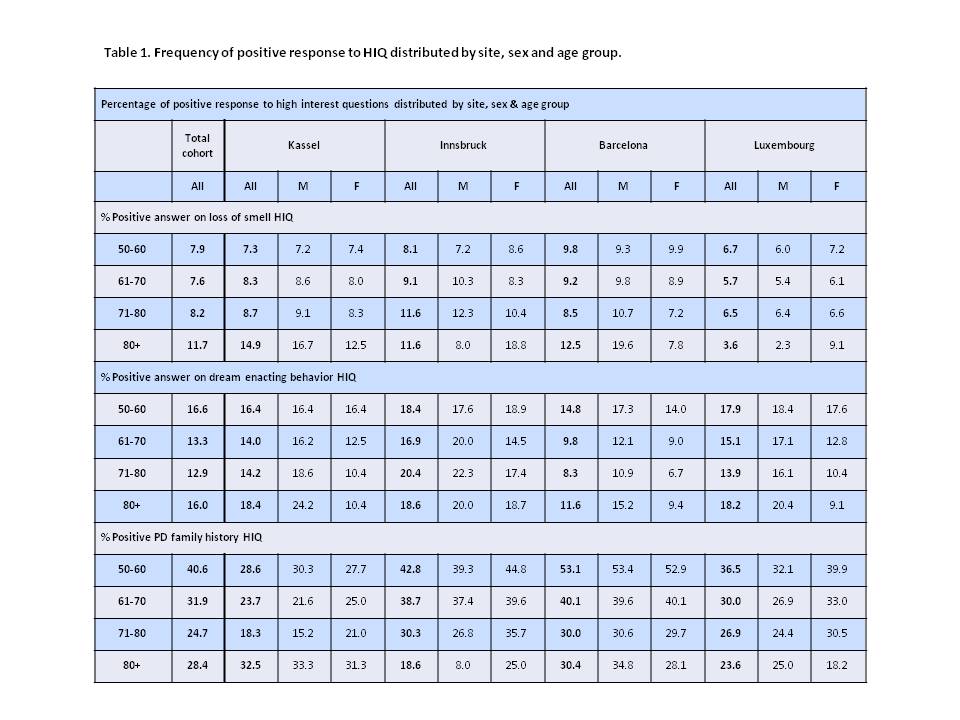Category: Parkinson's Disease: Non-Motor Symptoms
Objective: Describe the frequency of Parkinson’s disease (PD) risk factors in a European population-based study and analyze the predictive value of online survey single questions in detecting hyposmia as a risk marker for PD.
Background: Established PD risk factors include positive family history, REM sleep behavior disorder, and olfactory dysfunction, integral to MDS prodromal PD criteria[1]. The University of Pennsylvania Smell Identification Test (UPSIT) is commonly used for early PD screening, with hyposmia often defined by UPSIT scores (e.g., UPSIT≤18) or age- and sex-adjusted percentiles (e.g., UPSIT percentile <15)[2]. Population-based studies assessing the effectiveness of remote surveys on these factors are lacking.
Method: The Health Brain Aging (HeBA) Study[3] conducted an online questionnaire on healthy individuals aged 50 to 80, focusing on PD risk factors and markers, including high-interest single questions (HIQ) on smell loss, dream enactment behavior, and family history of PD, alongside validated scales. A subset, mostly deemed at high-risk, underwent remote olfactory assessment and clinical evaluation. Data collection occurred at four sites (Kassel, Innsbruck, Luxembourg, Barcelona) from 2022, employing varied recruitment strategies.
Results: The HeBA cohort includes 38,252 individuals (60.3% women, mean age 62.9, SD 7.8). Most participants (78%) were highly educated and independent (99%). Six percent reported smell loss, 11% endorsed dream enactment on HIQ, and 13.7% had a positive family history of PD. Two percent reported positive responses to two HIQ, and 1% to all three. Distribution of positive HIQ responses by age is shown in [figure 1]. No significant site differences were observed (p>0.5) [table 1]. Among UPSIT completers (n=5,548), 61.7% were women, mean age 62.6 (SD 7.8), with 18% reporting smell impairment. Impaired smell correlated with abnormal UPSIT percentiles, although yielding low sensitivity of 26% and 34% for percentiles 15th and 10th, respectively. Negative smell loss HIQ responses demonstrated 88% specificity.
Conclusion: Over two years of recruitment, the HeBA study, has established a well-characterized cohort for exploring PD risk factors in a population-based context. Remote olfaction assessment feasibility suggests potential for hyposmia screening as an early PD marker. Longitudinal follow-up and inclusion of biological markers will enhance understanding of early PD phases.
Figure 1
Table 1
References: [1] S. Heinzel, D. Berg, T. Gasser, H. Chen, C. Yao, R. B Postuma, MDS Task Force on the Definition of Parkinson’s Disease. Update of the MDS research criteria for prodromal Parkinson’s disease. Mov Disord 2019; 34(10):1464-1470.
[2] M. C Brumm, K. A Pierz, D. Lafontant, C. Caspell-Garcia, C. S Coffey, A. Siderowf, K. Marek. Updated Percentiles for the University of Pennsylvania Smell Identification Test in Adults 50 Years of Age and Older. Neurology 2023; 100(16):e1691-e1701
[3] C. Horlings, A. Garrido, C. Vega Moreno, S. Schade, T. Marques, P. Mahlknecht, C. Gomes, S. Ghosh, K. Rege, R. Rawal, C. Pauly, D. Mcintyre, K. Marini, K. Seppi, M. Marti, C. Trenkwalder, E. Tolosa, W. Poewe, V. Satagopam, R. Krüger, B. Mollenhauer. The Healthy Brain Ageing (HeBA) Parkinson’s disease risk survey: Study design and methods [abstract]. Mov Disord. 2023; 38 (suppl 1)
To cite this abstract in AMA style:
A. Garrido, C. Horlings, K. Rege, S. Schade, S. Ghosh, P. Mahlknecht, R. Rawal, T. Marques, D. Pilco, C. Gomes, C. Pauly, F. Farfan, D. Mcintyre, K. Seppi, MJ. Marti, C. Trenkwalder, W. Poewe, E. Tolosa, V. Satagopam, R. Krüger, B. Mollenhauer. Unveiling Parkinson’s Disease Risk Factors in the European Population-Based HeBA Cohort [abstract]. Mov Disord. 2024; 39 (suppl 1). https://www.mdsabstracts.org/abstract/unveiling-parkinsons-disease-risk-factors-in-the-european-population-based-heba-cohort/. Accessed April 3, 2025.« Back to 2024 International Congress
MDS Abstracts - https://www.mdsabstracts.org/abstract/unveiling-parkinsons-disease-risk-factors-in-the-european-population-based-heba-cohort/


